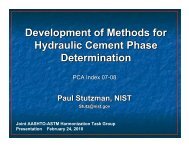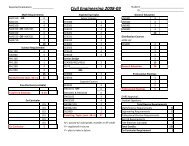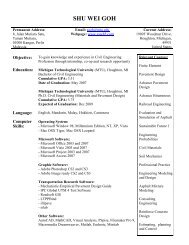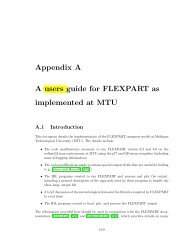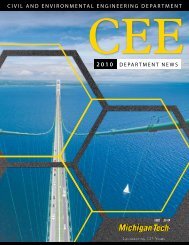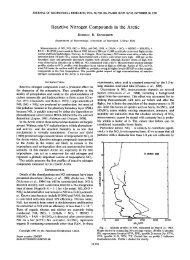Evaluation of Septic Tank and Subsurface Wetland for
Evaluation of Septic Tank and Subsurface Wetland for
Evaluation of Septic Tank and Subsurface Wetland for
Create successful ePaper yourself
Turn your PDF publications into a flip-book with our unique Google optimized e-Paper software.
Table 5-4 Ammonia (NH3-N) <strong>for</strong> Pisgah <strong>and</strong> Retrieve Sanitation Systems<br />
________________________________________________________________________<br />
Sample Arithmetic Mean 90% Confidence Sample<br />
( X ) mg/l Interval mg/l Size (n)<br />
Pisgah First <strong>Septic</strong> <strong>Tank</strong> 76 X ± 49<br />
5<br />
Pisgah Wetl<strong>and</strong> Influent 58 X ± 39<br />
5<br />
Pisgah Wetl<strong>and</strong> Effluent 0.4 X ± 0.5<br />
4<br />
Retrieve First <strong>Septic</strong> <strong>Tank</strong> 13.0 X ± 11<br />
6<br />
Retrieve Wetl<strong>and</strong> Influent 5.8 X ± 2.2<br />
6<br />
Retrieve Wetl<strong>and</strong> Effluent 0.4 X ± 0.5<br />
7<br />
It was determined that the Pisgah sanitation system removed an average <strong>of</strong> 95% <strong>of</strong> the<br />
total nitrogen <strong>and</strong> 99% <strong>of</strong> the ammonia from the wastewater. The Retrieve sanitation<br />
system removed an average <strong>of</strong> 68% <strong>of</strong> the total nitrogen <strong>and</strong> 97% <strong>of</strong> the ammonia. The<br />
Pisgah septic tanks removed 11% <strong>of</strong> influent total nitrogen <strong>and</strong> 24% <strong>of</strong> influent ammonia.<br />
The Retrieve septic tank removed 66% <strong>of</strong> influent total nitrogen <strong>and</strong> 55% <strong>of</strong> influent<br />
ammonia. It was determined that the Pisgah wetl<strong>and</strong> removed 95% <strong>of</strong> its influent total<br />
nitrogen. This was above the 60.1 – 64.8% removal efficiencies reported <strong>for</strong> horizontal<br />
SSF wetl<strong>and</strong>s (Vymazal, 2002). It was determined that influent concentration <strong>of</strong><br />
ammonia was reduced by 99% in the Pisgah wetl<strong>and</strong> <strong>and</strong> 93% in the Retrieve wetl<strong>and</strong>.<br />
This was above the 64% average ammonia removal efficiency reported <strong>for</strong> ten horizontal<br />
SSF wetl<strong>and</strong>s in Italy (Masi et al., 2000).<br />
At Pisgah the average total nitrogen <strong>and</strong> ammonia loads entering the wetl<strong>and</strong> were 0.87<br />
kg/ha-d N (0.78 lb/ac-d) <strong>and</strong> 1.69 kg/ha-d NH3-N (1.51 lb/ac-d). At Retrieve the average<br />
loads entering the wetl<strong>and</strong> were 6.8 k/ha-d N (6.1 lb/ac-d) <strong>and</strong> 0.17 kg/ha-d NH3-N (0.15<br />
lb/ac-d). Total nitrogen removal in the wetl<strong>and</strong> at Pisgah was 0.83 kg/ha-d (0.74 lb/ac-d)<br />
<strong>and</strong> ammonia nitrogen removal was 1.68 kg/ha-d (1.50 lb/ac-d). At Retrieve the data<br />
indicated an increase <strong>of</strong> total nitrogen through the wetl<strong>and</strong> <strong>and</strong> ammonia removal <strong>of</strong> 0.16<br />
kg/ha-d (0.14 lb/ac-d). The high ammonia removal compared to total nitrogen removal in<br />
both wetl<strong>and</strong>s could indicate error in the test results <strong>and</strong> the addition <strong>of</strong> particulate<br />
42



